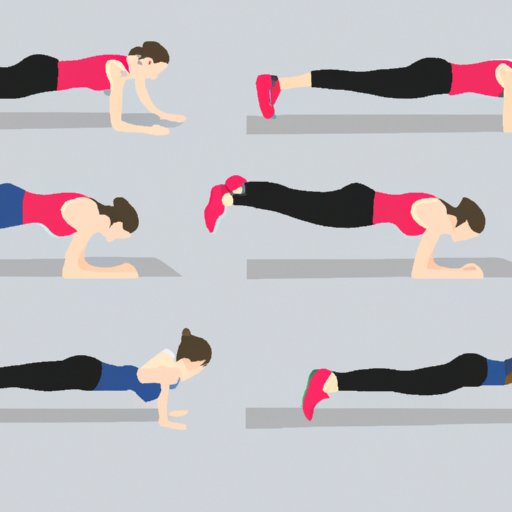
Introduction
If you haven’t already heard, planking is one of the best exercises for core strength. Not only that, but it can also work your arms, shoulders, back, and legs, making it a versatile exercise for your entire body! However, while it may seem simple, many people struggle with the proper form. In this article, we’ll be exploring how to do a plank correctly, common mistakes to avoid, and different variations to keep your routine fresh!
The Basics of a Plank
Before we dive into variations and weights, let’s start with the basics of a plank:
- Start on all fours with your wrists directly under your shoulders and your knees directly under your hips.
- Step your feet back one at a time, keeping your toes tucked to protect your knees. Your body should be in a straight line from your head to your heels.
- Engage your core and squeeze your glutes to hold your body in this straight line.
- Hold this position for as long as you can while maintaining proper form.
To help you visualize this, check out this helpful illustration:

Common Mistakes to Avoid
Just like with any exercise, there are common misalignments to watch out for when doing a plank:
- Sagging hips: Make sure to engage your core and glutes to keep your body in a straight line, avoiding sinking in the middle.
- Elbows too wide: Keep your elbows close to your body to engage your triceps and reduce strain on your shoulders.
- Head dropped or lifted: Keep your head in line with your spine to prevent neck strain.
If you find yourself struggling with any of these, don’t worry! Here are some tips to help correct these common mistakes:
- Imagine tucking your tailbone to engage your glutes and prevent sagging hips.
- Keep your elbows close to your ribcage and engage your triceps to prevent elbow strain.
- Imagine extending the crown of your head forward to keep your neck in line with your spine.
Proper form is crucial to avoid injury, so be sure to take your time and focus on form over duration!
Timing Your Plank
Now that you’re feeling more confident in your form, the next question is likely, “How long should I hold a plank?”
The answer will vary depending on your fitness level, but a good place to start is 20-30 seconds. From there, aim to gradually increase your hold time as your strength improves. Be sure to listen to your body and avoid pushing yourself too hard too soon, as this can lead to injury.
Here are some tips for progressively increasing the duration of your plank:
- Start with shorter hold times and work your way up gradually.
- Focus on maintaining proper form instead of holding for longer.
- Breathe deeply and rhythmically to help reduce strain on your body.
Switching Up Your Plank Routine
If you’re feeling bored with the basic plank, fear not! There are plenty of variations to keep things interesting:
- Side plank: Balance on one hand and the side of one foot, engaging your obliques.
- Plank with leg lifts: Alternately lift one leg off the ground, engaging your glutes and lower back.
- Plank with shoulder taps: In a basic plank, tap one shoulder with the opposite hand, engaging your core and shoulders.
- Forearm plank: Instead of placing your weight on your hands, balance on your forearms.
Here are some illustrations to help you visualize these variations:

Adding Weights to Your Plank
If you’re looking for an extra challenge, you can integrate weights into your plank routine. Here’s how:
- Place a weight on your back: Simply place a weight, such as a kettlebell, on your back as you hold your plank.
- Add a row: In a plank position, raise one arm to perform a row, engaging your back muscles.
- Add a twist: In a plank position, rotate your hips to one side and reach your opposite arm toward the ceiling, engaging your obliques.
When adding weights to your plank routine, it’s important to choose the right weights and maintain proper form to avoid injury.
Building Core Strength
Planking is an excellent exercise for building core strength, which can improve your posture, balance, and overall fitness. Here are some tips for building a core-strengthening routine that includes regular planking:
- Include planks in your workout routine 2-3 times per week.
- Vary the hold times and plank variations to keep your routine challenging.
- Combine planking with other core exercises, such as crunches and bicycles, to target different muscle groups.
Rest Days
While it’s important to build consistency in your fitness routine, it’s equally important to incorporate rest days to allow your body to recover. Here are some tips for incorporating rest days into your plank routine:
- Incorporate rest days into your workout schedule to allow your body to recover.
- Focus on stretching and other low-impact activities on rest days.
- Don’t sacrifice progress for consistency- it’s better to take a rest day than risk injury by overdoing it.
Conclusion
Overall, planking is an excellent exercise for building core strength and improving overall fitness.




